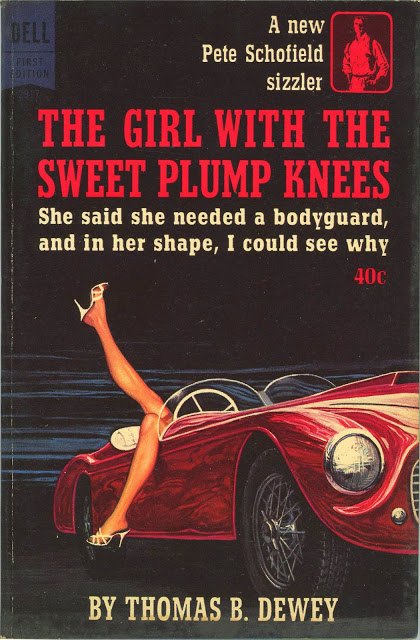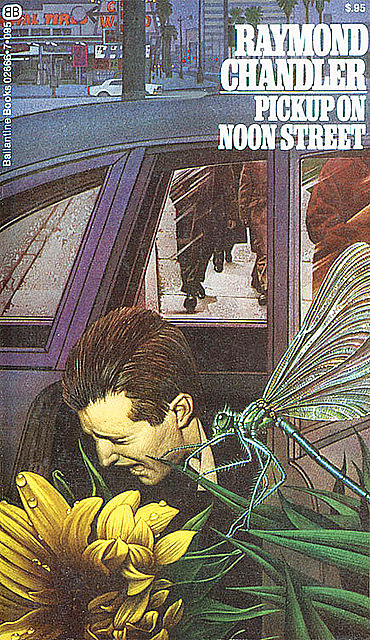You have no items in your cart. Want to get some nice things?
Go shoppingSeattle journalist and editor of crime fiction blog The Rap Sheet and book design blog Killer Covers, J. Kingston Pierce, explores the history of hand-painted crime and mystery book cover art in an age before stock photography took over our bookshelves.
 Women with desire and devilry in their eyes. Detectives with pistols in their paws and not enough luck to fill a matchbox. Damp, deserted roadways. Hot-sheet motels. Women in peril, their faces contorted with fear. Alleyways where young toughs threaten old fools. Bedrooms where the innocent go to sleep forever. Women with legs the length of Panama. Nightclubs where booming gunfire plays a discordant rhythm against the music.
Women with desire and devilry in their eyes. Detectives with pistols in their paws and not enough luck to fill a matchbox. Damp, deserted roadways. Hot-sheet motels. Women in peril, their faces contorted with fear. Alleyways where young toughs threaten old fools. Bedrooms where the innocent go to sleep forever. Women with legs the length of Panama. Nightclubs where booming gunfire plays a discordant rhythm against the music.
And women. Did I mention women? The more shapely and scantily attired the better.
During the mid-20th century, these were essential ingredients of the illustrations decorating American crime, mystery, and thriller novels, especially the paperbacks. Inspired by the dissident, dystopian aesthetic of film noir and the sensationalistic fronts of cheaply made pulp magazines that had done so much to popularise crime fiction, the artists behind these novel covers offered the browsers of bookstore shelves and drugstore spinner racks a world where anything could go wrong, and usually did. Their vision was fraught with lust and sadism, avarice and paranoia, slow-boiling terror and quick-firing violence. But if the society that artists such as Robert McGinnis, Paul Rader, Norman Saunders, and Ernest Chiriaka portrayed was often ugly, the art itself could be captivating. Many of them had honed their talents in the employ of slick periodicals and advertising agencies, before an increasing dependence on photography in those fields drove them to seek alternative work painting movie posters and paperback covers. Together they ushered in what Max Allan Collins, a prolific mystery novelist who’s also penned non-fiction works about genre book art and pin-up girls, calls “a wonderful golden age where utter sleaze meets genuine artistry.”
In our present era, when stock photography dominates and is too often duplicated on book fronts, and every other cover features a shadowy figure in flight, nostalgia for the unique and seductive illustrations of half a century ago is understandable. Too bad it’s unlikely to foment a renaissance of hand-painted wrappers anytime soon.
“Today, a lot of books are sold in large chain stores that make their money primarily by selling packaged goods – bologna, potting soil, diapers – and these stores take great pains to ensure they won’t offend any of their customers,” explains Charles Ardai, the editor of Hard Case Crime, a paperback publisher known for its original, classic-style illustrations. “Not a problem when your product is bologna or potting soil; the packages for those products are unlikely to stir any controversy. But book covers … might. And these retailers won’t stock books whose covers contain elements they feel might be risqué enough to cause some fraction of their customers to write nasty letters or start a boycott or simply start shopping at the next store over. Since these retailers wield a lot of power (by dint of the large fraction of all book sales they control), publishers are loath to cross them. So any cover image that might be ‘too sexy’ or sensitive in some other way is likely to get nixed before it’s even seen by the buyers for these stores – and if it’s not, it’s likely to get nixed by those buyers when they do see it.”
The dilemma facing designers of modern crime novels, then, is that in order not to offend, they may wind up creating covers devoid of the two most consistent characteristics of the crime-fiction story: sex and violence.
Collins says publishers are even queasy about displaying guns on books these days. He traces the start of the evolutionary shift away from painted covers and toward photographic ones to the late 1960s, “when what was perceived as a more modern look came along – a single stark image against a solid color, usually a beautiful woman … This more simple, uncluttered design opened the door for photo-art covers, for crime paperbacks particularly – you had, for example, McGinnis dolls on Perry Mason covers being replaced by photos of beautiful women. Paperback covers had caught up to magazines, in a bad way, substituting photography for illustration.”
Photo-based fronts were cheaper and less time-consuming to manufacture – all of which pleased publishers, who touted them as evolutionary leaps beyond their painted predecessors. Nowadays, says Ardai, “there are people who think that covers that look painterly and old-fashioned might actually sell less well – no matter how beautifully painted – than the modern-style generic stuff I think of as ‘supermarket covers,’ simply because the readers who buy bestsellers at supermarkets are looking for something that screams ‘modern,’ not something that looks strange or old-timey.”
Fortunately, sex, violence, and firearms of multiple menacing calibers can still be appreciated on vintage crime novel fronts. I’ve collected here a dozen of my favorite examples – not necessarily the “best” of the breed, but representing an artistic style that capitalized on the genre’s passionate, visceral rudiments and led readers, mostly men, to reach for their wallets.
 Murder Is Dangerous by Saul Levinson (Handi-Books, 1951)
Murder Is Dangerous by Saul Levinson (Handi-Books, 1951)
Artist: Norman Saunders
This illustration’s offbeat perspective – the book isn’t upside down, but shows a man falling to his death! – grabs your attention immediately. And it perfectly introduces a story about a crazed killer and business conspiracies in East Texas oil country.
 The Corpse Came Calling by Brett Halliday (Dell, 1955)
The Corpse Came Calling by Brett Halliday (Dell, 1955)
Artist: Robert E. Schulz
Fronting Halliday’s sixth novel to feature the “toughest red-head ever,” Miami shamus Mike Shayne, this is one of many “bondage covers” popular after World War II. Especially affecting is the woman’s terrified gaze beyond the frame. We don’t know what violence awaits in this story about a decoy girl in a divorce racket, but there’s no doubt it’s coming. Fast.
 The Last Kill by Charlie Wells (Signet, 1955)
The Last Kill by Charlie Wells (Signet, 1955)
Artist: Robert A. Maguire
Maguire created hundreds of covers before his passing in 2005. His artwork for The Last Kill, a crackling tale about Memphis, Tennessee-based gumshoe Steve Lee, ranks among his most striking. The question is whether the woman shown here intends to defend her lover’s life … or end it.
 Three Day Pass – to Kill by J.W. Burke and Edward Grace (Berkley, 1958)
Three Day Pass – to Kill by J.W. Burke and Edward Grace (Berkley, 1958)
Artist: Paul Rader
Known, in part, for the sensuous covers he painted for soft-porn paperbacks, Rader brought that same eye for feminine details to this thriller about a man who has only a short time to clear himself of rape and murder. The soft figure and smoking gun, backdropped by the hues of heat and passion, carry all sorts of dangerous implications.
 Kill Now, Pay Later by Robert Kyle (Dell, 1960)
Kill Now, Pay Later by Robert Kyle (Dell, 1960)
Artist: Robert McGinnis
Now in his early 80s, McGinnis began painting paperback covers half a century ago, and established a style familiar for its impossibly deep-cleavaged and long-legged lovelies. He’s developed more than 1,500 paperback fronts for authors such as Erle Stanley Gardner, Brett Halliday, and Carter Brown. Kill Now, Pay Later, the third of five clever novels penned by Kyle (a pseudonym of Robert Terrall) and starring New York private eye Ben Gates, is an excellent example of McGinnis’ languid, elegant imagery.
 Cain’s Woman by O.G. Benson (Dell, 1960)
Cain’s Woman by O.G. Benson (Dell, 1960)
Artist: Ernest Chiriacka
The story is about a private eye falling under the spell of an alluring woman who claims she’s being blackmailed with sexually explicit photos. It’s only appropriate that Chiriacka – who signed his work “Darcy” – should cast his own spell over the reader with this intimate and misleadingly peaceful illustration.
 The Kilroy Gambit by Irwin R. Blacker (Signet, 1962)
The Kilroy Gambit by Irwin R. Blacker (Signet, 1962)
Artist: Mitchell Hooks
Inspired by Blacker’s story of espionage activities in Afghanistan half a century ago, Hooks overlaid the exoticness of an Arab city with the outline of a furtive figure handcuffed to a briefcase to produce a cover that positively screams “spy novel.”
 Anything But Saintly by Richard Deming (Permabooks, 1963)
Anything But Saintly by Richard Deming (Permabooks, 1963)
Artist: Robert K. Abbett
What’s most interesting about the cover of this novel, which has to do with vice and corruption in a small town, is how much is left to the imagination. We have the suggestion of a shapely hip and a bared midriff, and the woman’s penetrating gaze, but the rest must be filled in with a combination of anatomical knowledge and human desire.
 The Girl with the Sweet Plump Knees by Thomas B. Dewey (Dell, 1963)
The Girl with the Sweet Plump Knees by Thomas B. Dewey (Dell, 1963)
Artist: Victor Kalin
Kalin was known for his dramatic pieces, but Dewey’s private eye Pete Schofield novels tended to be light-hearted. For this yarn about a boxer’s girlfriend in need of some protection, Kalin pairs the car’s potential for speed with the raciness of the naked gams.
 Pickup on Noon Street by Raymond Chandler (Ballantine, 1971)
Pickup on Noon Street by Raymond Chandler (Ballantine, 1971)
Artist: Tom Adams
Following his work on a series of Agatha Christie covers, Adams turned out a line of 10 Chandler paperback fronts, which mixed natural elements – flowers, fish, rattlesnakes, etc. – into scenes of human death and danger. The winged insect on Pickup is beautifully part of, and yet quite divorced from, the frightening drama at hand.
 Sleeping Beauty by Ross Macdonald (Knopf, 1973)
Sleeping Beauty by Ross Macdonald (Knopf, 1973)
Artist: Hal Siegel
For the cover of this detective novel about murder and a California coastal oil spill, Siegel took a design theme from Bantam Books’ 1970s paperback editions of Macdonald’s work – narrow photos of women beneath bold titles – and substituted his painting of a young miss either reclined on a surrealistic sofa, or floating in a shimmering oil slick.
 Bury Me Deep by Harold Q. Masur (Quill Mysterious Classics, 1984)
Bury Me Deep by Harold Q. Masur (Quill Mysterious Classics, 1984)
Artist: Irving Freeman and Steve Macanga
Its knockout cover captures the equally unforgettable opening scene in this novel, which finds New York investigating attorney Scott Jordan shooing an underdressed and uninvited guest from his apartment – only to later defend himself against charges that he poisoned the woman before sending her home in a cab.

About J. Kingston Pierce
J. Kingston Pierce is the editor of The Rap Sheet, the author of the classic book art appreciation site, Killer Covers, and the senior editor of January Magazine. He’s also the lead crime-fiction blogger for Kirkus Reviews.





What’s up,I read your blog named ““Where Sleaze Meets Artistry”: 12 Great Crime Novel Covers” regularly.Your story-telling style is awesome, keep doing what you’re doing! And you can look our website about proxy server.